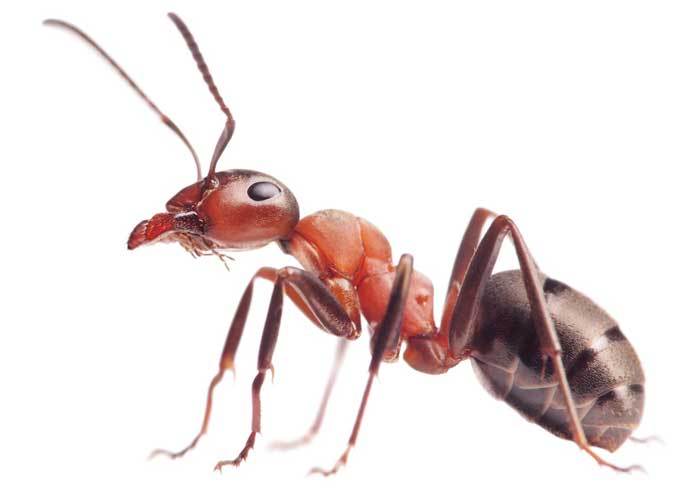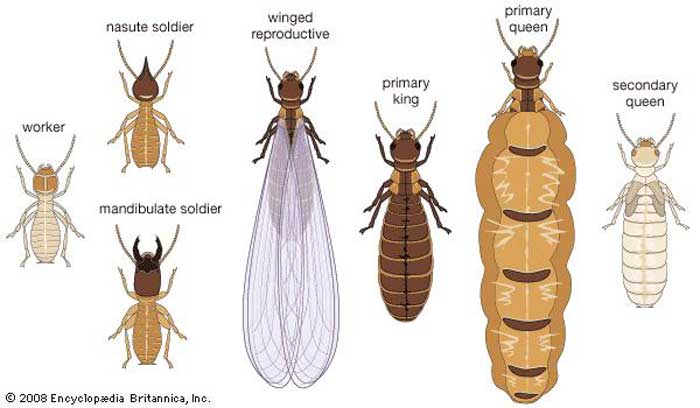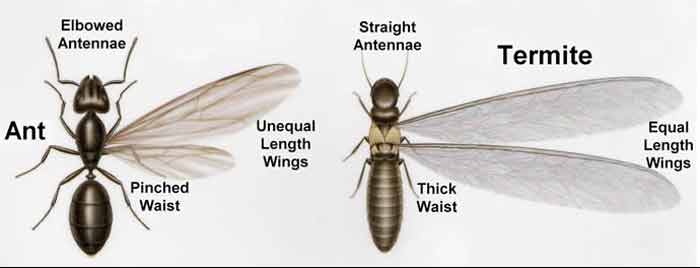There are uncountable insect species in the world. Most of the insects have so many similarities that distinguishing them is extremely difficult. Flying ants and termites are some of the mostly confused insects.
If you wish to control an infestation of either of the two insects, you must first be certain of which insect you are dealing with. The similarities and differences between the two insects are discussed in this article.
Table of Contents
Termites vs ants
There are several similarities between ants and termites. They include the following;
- Ants and termites are both insects since they have three body parts (head, thorax and abdomen) and 3 pairs of legs that are jointed.
- During spring, the two insects create swarmers and send them to go and create new colonies. The swarmers nest in wood, under rocks or in moist soil.
- Ants and termites live in colonies. You can therefore find them in colonies on the walls of your home.
- These two insects love the wood and they are mostly found around areas with plenty of wood.
- They are almost the same size and you will need a closer look if you are to distinguish between the two.
These similarities make it difficult to establish which of the two has actually infested your home. All the same, you can draw some differences by comparing key features of the two insects as discussed below;
Color
Ant workers are dark colored, mostly red and are commonly seen in the open looking for food. Termites on the other hand are lighter and may be creamy white in color. Termites are rarely seen since they do not spend most of their time in the open.
Antennae
Termites have straight antennae that are beaded. The ants on the other hand have elbowed or rather bent antennae.
Waist
The waist of ants is more narrow and constricted when compared to that of termites. Termites are found to have a broad waist. For this reason, the termites appear to have a uniform width all through the body. Ants on the other hand are segmented.
You can also draw other differences based on the behavior relating to these two insects as follows;
Diet
Termites survive on a cellulose diet majorly from wood and plants. The termites can also eat into cardboards as long as they find cellulose.
Cellulose provides them with all necessary nutrients. Ants on the contrary have a diverse diet. They are omnivore. They eat seeds, nectar, other insects, and food debris.
Roles in the colony
For the termites, the soldiers and workers can either be the male or the female termites. Ants have females as the soldiers and workers and no males are involved in that role.
Stages in their life cycle
Some differences can be pointed based on the life cycle of the two insects. Ants have four development stages in their life cycle.
The first stage is egg, then larvae, pupa and finally adult. Termites on the other hand have three stages in their life cycle.
The stages are egg, nymph and adult; respectively. After mating, the male and female termites continue with their life while the male ant dies after the mating process.
Life span
The ants classified as workers survive only for a few months. The queens on the contrary can live for years. Termites live for many years while the queens of the termites can survive for decades.
Destruction caused
Termites are extremely destructive as they feed on any wood that is not termite resistant. The damage caused by termites may need you to spend a lot of money.
Ants on the other hand do not cause any significant damage and the worst they can do is be a nuisance to you. American citizens spend billions in controlling and treating termite infestations.
Mud tubes
If there are mud tubes on the infested area, you should suspect presence of termites rather than ants. This is because, it is termites and nit ants that use mud tubes as passages and travel ways.
Flying Ants vs Termites
You will find it more difficult to tell the difference between termites and flying ants if you have winged termites around your home. In such a case, the insects will appear the same and you must look keenly to identify the key differences.
Wings are the key feature and the following differences in the way the wings of the two insects appear will be helpful;
- Both of the insects have two sets of wings and length is the only factor you can use to distinguish the two. The wings of termites are equal in length and the general size. Those of the ants on the other hand are not equal.
- The pair of wings of the flying ants at the back is relatively smaller than those at the front.
- Another way to differentiate the termites from the winged ants is that the termites shed their wings when mating while the flying ants are not found to shed their wings.
- The wings of the termites are two times as long as the body of the termites. Ants, however, have shorter wings which are found to be proportionate to their bodies.
- Looking at the durability of the wings of the two insects, the wings of termites easily fall off. You can see these loose wings at the openings of nests and this is a clear indicator that you have a termite infestation and not an ant infestation.
- While the flying termites are considered to be destroying insects, flying ants are not considered a threat as they are in most cases foraging for food.
Carpenter Ants vs termites
Carpenter ants are known to burrow into wood with an aim of making a nest. This is perhaps why they are mostly confused with drywood termites. You can however differentiate them by considering a number of things as discussed below;
- While the nest constructed by the carpenter ants is very smooth, that of the termites is very messy.
- Carpenter ants just burrow into the wood but they do not eat it. Termites on the contrary eat into the wood with an aim of acquiring cellulose.
- If you compare the damage caused by the two insects; that of the termites is more extensive given they actually eat the wood. Carpenter ants cause relatively less damage and the damage is only around the nesting area.
- The nest of the carpenter ants is very neat while that of the termites is untidy and is likely to have some mud tubes.
- You can as well differentiate the carpenter ants from termites by looking at their bodies. The body of the carpenter ants resembles that of termites in that it has a slim body especially on the edge connecting the thorax and the abdomen. The termite on the other hand has a body of uniform width.
- The debris that carpenter ants leave behind after burrowing into the wood are similar to saw dust. They are wood shaving of different size and shapes. Termites on the other hand leave behind wood pellets of equal size and shape.
- In case of carpenter ant swarmers and termite swarmers, you can differentiate the two by looking at a number of things. Carpenter ant swarmers are black but could sometimes be a combination of red and black. Termite swarmers are found to have a color ranging from dark brown to black.
- The wings of the carpenter ant swarmers are reddish brown hue. They lay over posterior. The wings of termite ants are slightly milky and some people describe them as having a smoky appearance. The termite wings also overlap.
- You will find carpenter ants mostly on moist and damaged wood. Carpenter termites not only attack the decaying wood but also eat into the sound wood.
- You can control carpenter ants by simply eliminating the conditions that are suspected to be attracting them. However, to terminate a termite infestation, you require professional intervention.
Carpenter Ant Frass vs Termite Frass
Frass refers to waste matter or droppings from these two insects. You can differentiate the frass by discussing the droppings of the two insects differently.
Carpenter ants frass
Ants produce waste product after their wood excavating activities and after taking their normal diet. The waste product is referred to as carpenter ant frass. It is usually piled next to their nests. The frass from carpenter ants resembles saw dust materials.
The carpenter ant droppings is made up of feces, parts of dead ants, and chewed food fragments. The frass appears to be fibrous bits of wood that are very soft.
The droppings are usually the color of the recently excavated wood. They are normally in a pile that resembles the shape of a cone.
Termite frass
Unlike the carpenter ants frass, that of the termites only constitutes of fecal matter. The drywood termite droppings are the ones that are commonly confused with those of carpenter ants.
Drywood termites’ frass is usually very tiny and has an oval shape. It has six sides which are concave and the ends are rounded.
The droppings of the termites will be found beneath the exit holes. The frass forms mounds resembling piles of pepper or salt. The pellets forming these piles are usually a millimeter long.
Further Reading
- How to Get Rid, Kill Termites + Treatment Cost
- What Causes & Attracts Termites?
- Do Termites Bite Humans? Pictures & Remedies
- Flying Ants vs Termites-Differences & Similarities
- Termite Inspection Cost, Procedure, how long it takes & Training
- Termite Colony-Queen, Soldier, Worker & King
- Drywood Termites Treatment Cost, Get rid & Damage
- Termite Bond Cost, Benefits
- Termite Baits, Stations & DIY Traps
- Dampwood termites Pictures, Damage & Treatment
- Termite Tenting & Fumigation- Cost, Preparation, Safety & Cleaning After
- Termite Barriers (Shields): Types, Cost, how they Work & Products
- Termites Damage, Pictures, Repair Cost, Ceiling, Floors, Wood & Fix
- Best Termite Sprays-Orange Oil (DIY), Boric Acid & Spectracide Reviews
- Termites Life Cycle & Span-Eggs, Larvae, Baby & Adults
- How to Prevent Termites-Tips to Protect your Home
- Signs of Termites Infestation-How do you know if have you them?
- What do Termites look like? Pictures, Size, Color & Look-alikes
- Termites: Where From, Habitat, Eat, Noise, Types +more!
- Subterranean Termites Swarmers Treatment Cost, Damages & Pictures
- Flying Termites with Wings (Swarmers) Pictures & How to get Rid
- Termite Droppings-Drywood, what they look like, Health Risks, Clean vs Sawdust
- Formosan Termites Pictures, Signs Treatment & Damage


